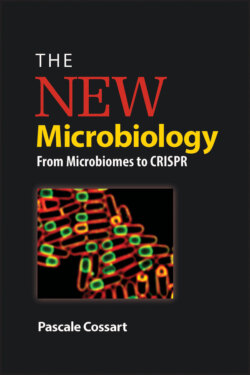Читать книгу The New Microbiology - Pascale Cossart - Страница 13
Repressors and activators
ОглавлениеThe operon model has been shown to occur in all bacteria, other prokaryotes, and some eukaryotes (particularly in worms such as the nematode Caenorhab-ditis elegans). It has thus been refined and enriched. We now know that genes can be repressed by a variety of repressors that more or less resemble the Lac repressor. Certain genes can be repressed by several repressors but others may also be activated. In this case, it is not a negative regulation that occurs, as for the lac operon, but a positive regulation, with an activator protein that binds upstream of the operon when specific conditions require genes to be expressed. One of the best-known activator proteins in bacteria is the protein CAP or CRP in Escherichia coli, which binds cyclic AMP, a molecule that acts as a hormone and can activate genes involved in the use of sugars other than glucose in bacteria.
Some repressors and activators present in bacteria can also be found in bacteriophages, viruses that attack bacteria. Bacteriophages, or phages for short, are essentially made of DNA and a few proteins packaged within an outer coat of proteins. The protein cl is a major player in the life of the phage lambda.
Phages, such as lambda phage, can be lytic or lysogenic. A phage is lytic if it causes lysis (from the Greek lysein, meaning to dissolve) of the infected host cell. Lysis occurs when a phage injects its DNA into a bacterium. The DNA circularizes and proceeds to replicate into new bacteriophages until the sheer number of them makes the bacterium explode. In contrast, a phage is lysogenic if the phage's DNA, injected into the bacterium, becomes integrated into the host bacterial cell's chromosome and becomes silent. In some conditions, it can excise and again act as a lytic phage.
The cI protein is a regulator at the heart of both the lytic and lysogenic situations in the lambda phage. cI is able to behave like a repressor when the phage DNA integrates itself into the bacterial genome. cI inhibits the expression of bacterial excision genes that allow the phage DNA to excise from the bacterial chromosome. If bacteria are stressed, irradiated, or grown in certain nutrient deficiencies, the bacterial protein RecA is activated. It cleaves the cI protein, allowing excision to occur.
Figure 6. (Left) The three 1965 Nobel Prize winners François Jacob, Jacques Monod, and André Lwoff. (Right) Jacob, Monod, and Lwoff's famous model proposing two possible alternatives for a simultaneous repression of the three genes in the lactose operon. Note that RNA here plays the role of the repressor.
However, in the beginning of the 1980s, it was found that the replication of plasmids—small circular minichromosomes that carry certain accessory genes, such as those for virulence or antibiotic resistance—is controlled by small RNAs that attach (or hybridize) to single strands of the plasmid’s DNA and prevent the plasmid’s replication. The concept of antisense RNA was thus born and the RNA revolution began.
Several other antisense RNAs were then discovered in bacteria, but no one could have foreseen the explosion of knowledge in the early 2000s following the discovery of microRNAs in eukaryotes. MicroRNAs are small RNAs with 22 nucleotides that attach to the 3' region of eukaryotic RNA and affect its translation. This surge of new discoveries was made possible by revolutionary new technologies, in particular the DNA chips called tiling arrays and new ultrarapid sequencing methods for genomes and RNA. These techniques allowed for the analysis of the ensemble of RNA transcripts of bacteria grown under a variety of conditions and led to the discovery that bacteria express a large number of RNA transcripts that do not encode proteins. These transcripts, called noncoding RNAs, are often the product of the intergenic regions of DNA and can act as regulators. Bacteria can have as many as several hundred distinct noncoding RNAs.
Many RNAs originally categorized as noncoding RNAs or as regulatory RNAs do regulate gene expression themselves. They can also code for small peptides. This is the case for RNAIII of Staphylococcus aureus.
While investigating the noncoding RNA in the bacterium Streptococcus pyogenes, the research group led by Emmanuelle Charpentier in 2010 made an extremely important discovery. They demonstrated that a small RNA known as tracrRNA, or trans-activating CRISPR RNA, plays a critical role in how the CRISPR system (for clustered regularly interspaced short palindromic repeats) recognizes invading phages and, more specifically, is involved in the destruction of these phages. This research has led to spectacular and unexpected developments, in particular the revolutionary technology called the CRISPR/Cas9 technology for the modification of genomes, as described in the next chapter.
